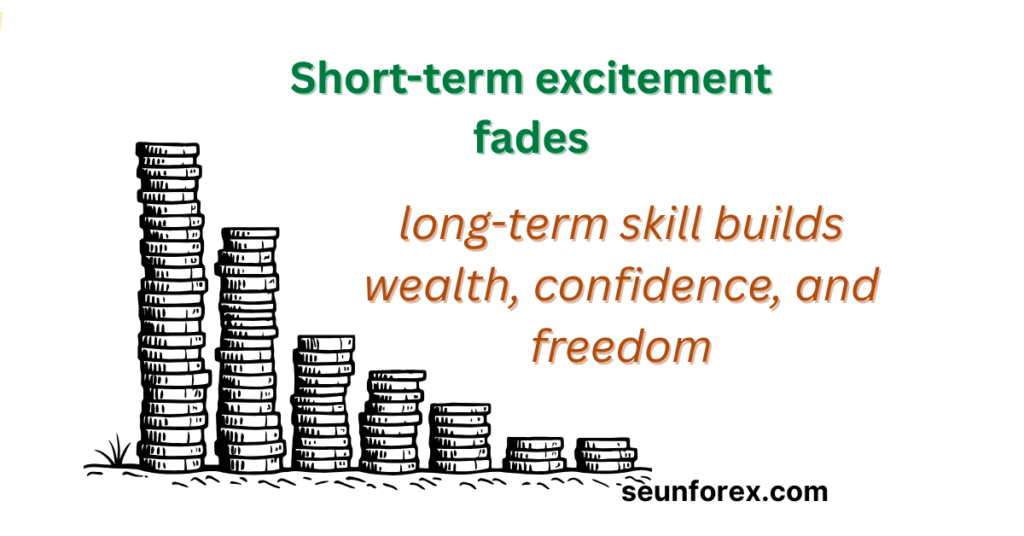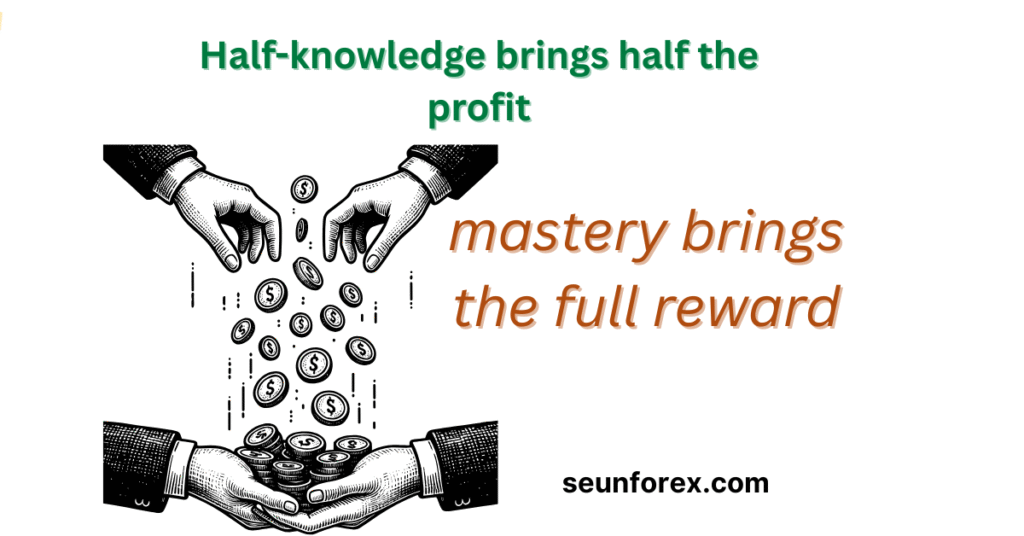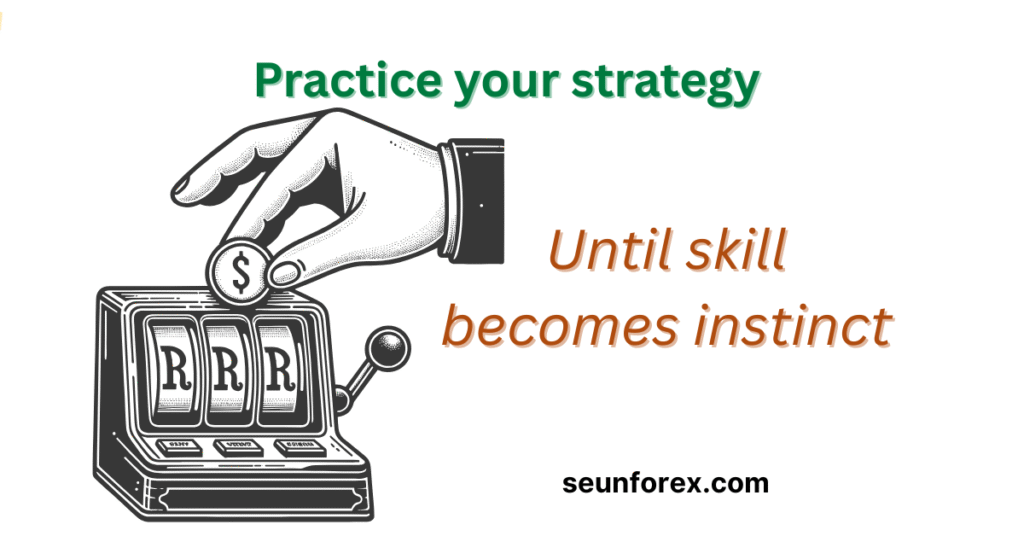
🧠 Introduction: The Hidden Trap of Strategy-Hopping
Trading is one of the few professions where your results are entirely determined by your own decisions. There’s no boss grading your work, no strict schedule—success comes from your discipline, analysis, and execution.
But freedom comes with hidden traps. One of the most subtle yet destructive is changing trading strategy too often. Every week, forums, YouTube channels, and social media influencers promise “the next big system” or “instant edge.” You’re tempted to jump from EMA crossovers to Fibonacci retracements, RSI filters, or some exotic combination that promises triple-digit gains.
Here’s the catch: constantly changing trading strategy may give a dopamine rush, but it erodes your trading profits, reduces consistency, and prevents you from mastering proper risk management. Even the most promising trading strategy loses its edge when you fail to stick with it long enough to understand its nuances.
This guide explores 10 reasons why changing trading strategy too often is killing your profits and how focusing on one strategy can help you build confidence, refine your trading edge, and grow long-term trading profits.
1️⃣ 🎯 Tactical Whiplash Destroys Focus
Tactical whiplash happens when you jump between strategies so often that you lose your mental focus and consistency. Each system has its own rules, indicators, and timing. Constant switching prevents you from internalizing any of them.
Example: You trade EMA crossovers one week. The next week you’re trying Fibonacci retracements. Your brain doesn’t have time to develop instinctive recognition of high-probability setups.
Consequence: Missed entries, poorly placed stops, and inconsistent exits. Even a strategy with a positive edge fails without focused execution.
📝 Exercise: Build Focus
| Step | Task |
|---|---|
| 1 | Pick a single strategy. |
| 2 | Trade 30–60 setups on demo or micro-live. |
| 3 | Journal every entry, exit, and outcome. |
| 4 | Review weekly to identify patterns and mistakes. |
2️⃣ 🔥 Short-Term Excitement vs. Long-Term Skill

The thrill of a new strategy is dopamine-driven. Every new indicator or system feels like progress—but excitement is not skill.
Psychology: Novelty triggers dopamine, creating a false sense of accomplishment. Traders mistake emotional highs for strategic insight.
Reality: Profits are built through repetition, discipline, and mastery of one system over time—not through chasing shiny setups.
💡 Mini Case Study:
- Trader A: switches strategies weekly and sees 3–4 “wins” but overall loses money.
- Trader B: sticks to a single strategy, journaling 100 trades. Even with losses, Trader B’s account grows steadily as they develop intuition and discipline.
Lesson: Fluency beats novelty. Focused practice compounds your edge over time.
3️⃣ ⚠️ Drawdowns Look Scarier Without Context
Every trading system has losing streaks. When you switch strategies too soon, you never see whether a drawdown is normal or catastrophic.
Scenario: Trader hops to a new system after losing 2 trades out of 3. They declare it broken, abandoning a system that could have produced profits over 50+ trades.
Reality: A system with a 60% win rate and 1:3 risk-to-reward ratio naturally has small drawdowns. Short-term losses are normal.
📝 Exercise: Understanding Drawdowns
| Step | Task |
|---|---|
| 1 | Trade your strategy for at least 30–60 setups. |
| 2 | Track losing streaks and calculate their frequency. |
| 3 | Compare results to expected drawdown of the strategy. |
| 4 | Reflect: Did emotional reaction impact decisions? |
4️⃣ 📊 Inconsistent Data Leads to Poor Decisions
Switching strategies constantly ruins your metrics. Without clean, consistent data, you can’t identify what works.
Metric Chaos: Win rate, average R-multiple, expectancy—all become meaningless when trades come from different systems.
Example: A trader tries three strategies simultaneously and sees an overall 45% win rate. They think the strategy is failing, not realizing one system is actually profitable.
📝 Exercise: Track Metrics Properly
Example Trade Journal Table:
| Date | Strategy | Entry Price | Stop | Target | Result | R-Multiple | Notes |
|---|---|---|---|---|---|---|---|
| 2025-09-01 | EMA Crossover | 1.2250 | 1.2230 | 1.2300 | Win | +2 | Clear trend, good volume |
| 2025-09-02 | EMA Crossover | 1.2280 | 1.2250 | 1.2320 | Loss | -1 | Late entry, whipsaw |
Formula for Expectancy:
Expectancy = (Average Win × Win Rate) – (Average Loss × Loss Rate)
5️⃣ 🧠 Psychological Fatigue and Decision Paralysis
Each new strategy demands learning rules, indicators, and setups. Constant switching causes mental exhaustion, confusion, and overthinking.
Story: A trader tests three strategies in one week. By Friday, they miss signals, misplace stops, and take revenge trades—turning potential profits into losses.
💡 Tip:
- Master one system at a time.
- Structure your trading day: market analysis → signal scanning → execution → review.
- Journal every decision to offload memory and mental energy.
6️⃣ 💪 You Never Build Confidence
Confidence is a hidden edge in trading. Without it, even profitable systems underperform.
Example: Trader B trades 100 setups on a single system. Even with losses, they develop intuition about setup quality, timing, and risk. Trader A switches constantly, always second-guessing.
Lesson: Confidence comes from repetition, not novelty.
7️⃣ ⚡ Risk Management Gets Compromised

Each strategy has an ideal risk profile. Constantly switching without adjusting risk parameters leads to oversized positions, poor stops, and emotional overtrading.
📝 Exercise: Define Risk Rules
| Parameter | Rule |
|---|---|
| Max Risk per Trade | 1–2% of account |
| Max Daily Loss | 3–5% of account |
| Stop Placement | ATR 1–2x or fixed pips |
| Reward-to-Risk Ratio | Minimum 2:1 |
8️⃣ 🎯 You Miss the Edge That Comes With Mastery
Every strategy has subtle edges that only appear after repeated practice.
Example: Fibonacci retracements seem random at first. After 50+ trades, a trader notices consistent confluence with support/resistance and trend direction.
Reality: Switching strategies constantly prevents reaching this insight.
9️⃣ 🌐 Social Media FOMO Traps You
Social media bombards traders with new strategies, winning screenshots, and “expert advice.”
Problem: Traders copy setups without understanding context, risk, or timeframe.
Outcome: False confidence, inconsistent execution, and wasted trades.
💡 Tip:
- Schedule social media breaks.
- Focus on executing your plan, not chasing external validation.
10️⃣ ⚖️ Half-Knowledge Leads to Half Profits

Trying multiple strategies simultaneously often produces:
- Half-baked setups
- Missed signals
- Erratic execution
Even if each system is profitable on paper, fragmented learning reduces overall expectancy.
Tip: Deep practice—rather than scattered curiosity—is the path to fluency and consistent profits.
🏆 Bonus: How to Fix Strategy-Hopping
- Pick one strategy with a clear edge – define rules for entry, exit, and risk.
- Timebox testing – 30 trades demo → 30 trades micro live → 30 trades evaluation.
- Journal every trade – record setups, emotions, outcomes, and mistakes.
- Track metrics – win rate, expectancy, R-multiple, max drawdown.
- Start small – scale only after consistent results.
- Limit external inputs – disable YouTube recommendations, mute forums.
- Evaluate objectively – wait for statistical significance, not short-term results.
📊 Case Study: Strategy-Hopper vs. Disciplined Trader
Trader A: Hopper
- Changes strategy weekly
- Loses track of rules and setups
- Inconsistent metrics and execution
- Result: 6 months of stagnation
Trader B: Disciplined
- Picks one strategy, journals 100 trades
- Analyzes data, adapts risk, survives drawdowns
- Builds confidence and fluency
- Result: 12 months of steady growth
Lesson: Mastery beats curiosity every time.
🏋️ Practical Exercises to Cement Mastery

- Trade Journal Exercise – Track 60+ trades with entries, exits, R-multiple, and notes.
- Drawdown Simulation – Record losing streaks and observe psychological reaction.
- Metric Analysis – Calculate expectancy and average R-multiple.
- Weekly Reflection – Answer: “Did I follow my rules? Did I learn anything new?”
- Social Media Detox – 1 week with no new systems allowed.
💡 Pro Tip: For traders who want to deepen their knowledge and complement these exercises, check out the best forex trading books for beginners in 2025. These resources provide actionable strategies, step-by-step guidance, and insights to improve your trading edge, risk management, and consistency. Clicking the link gives you access to curated books that save hours of trial-and-error and help you accelerate mastery of your chosen strategy.
✨ Conclusion: Fluency > Fragmented Curiosity
Switching strategies frequently is a hidden profit killer. It causes tactical whiplash, inconsistent data, emotional fatigue, compromised risk management, and missed mastery.
Key Takeaways:
- Pick one strategy and stick with it for 60–100 trades.
- Track performance objectively.
- Reduce social media distractions.
- Focus on fluency, not novelty.
- Repetition, discipline, and experience are the real trading edge.
Your profits aren’t in chasing shiny new systems—they’re in mastering the one you have.